 What I thought was Beihai Park was actually Sichahai. I think I got my directions wrong so instead of going south towards Beihai, I walked north. As I entered, a group of rickshaw drivers started to pester me. They were showing me a map and saying that it was too far to walk. And that they would take me around the sites. I pretended not to be interested and from RMB180 which is the price in the map, they offered to take me around for an hour for RMB50.
What I thought was Beihai Park was actually Sichahai. I think I got my directions wrong so instead of going south towards Beihai, I walked north. As I entered, a group of rickshaw drivers started to pester me. They were showing me a map and saying that it was too far to walk. And that they would take me around the sites. I pretended not to be interested and from RMB180 which is the price in the map, they offered to take me around for an hour for RMB50.
 So we went around beginning in Houhai or the west bank. I did not realize it until I did some research that what I actually did was a tour of the Beijing hutongs, which are narrow maze-like lanes and alleys that were typical of Beijing communities in the olden days.
So we went around beginning in Houhai or the west bank. I did not realize it until I did some research that what I actually did was a tour of the Beijing hutongs, which are narrow maze-like lanes and alleys that were typical of Beijing communities in the olden days.
Sichahai is the lakes area north of Beihai Park. You can walk around the lakes and into some of the old hutong alleys. There are also a lot of restaurants and bars along the lakes, especially in the southern tip of Qianhai called Lotus Lane.
 The driver took me to an alley with a lot of shops. I wasn't the one who wanted to go shopping but I just hit the tourist shop area of Beijing where in my opinion, the best Chinese souvenirs could be purchased at affordable prices, if you know how to bargain. I got myself an English version of Quotations from Chairman Mao Zedong (毛主席语录) which is known in the West as The Little Red Book. It is second only to the Bible in volume with over 900 million copies printed.
The driver took me to an alley with a lot of shops. I wasn't the one who wanted to go shopping but I just hit the tourist shop area of Beijing where in my opinion, the best Chinese souvenirs could be purchased at affordable prices, if you know how to bargain. I got myself an English version of Quotations from Chairman Mao Zedong (毛主席语录) which is known in the West as The Little Red Book. It is second only to the Bible in volume with over 900 million copies printed.
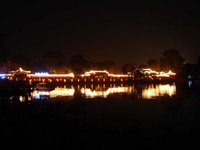 We went around more hutongs but since it was already getting dark, I wasn't able to appreciate it that much. The driver also brought me to some traditional houses which were converted into museums but I didn't want to spend for entrance which was about RMB40 each.
We went around more hutongs but since it was already getting dark, I wasn't able to appreciate it that much. The driver also brought me to some traditional houses which were converted into museums but I didn't want to spend for entrance which was about RMB40 each.
 When the tour ended, I took a walk again in Sichahai, this time along Lotus Lane which was flooded in lights (above right). The restaurants looked very appealing but again, I was on a very tight budget so I decided to have dinner elsewhere. I saw a structure from a distance and it turned out to be the Drum Tower or Gulou. So I walked towards it.
When the tour ended, I took a walk again in Sichahai, this time along Lotus Lane which was flooded in lights (above right). The restaurants looked very appealing but again, I was on a very tight budget so I decided to have dinner elsewhere. I saw a structure from a distance and it turned out to be the Drum Tower or Gulou. So I walked towards it.
Right beside the Drum Tower was the Bell Tower or Zhonglou (left). It was quite difficult to get a good shot of the Drum Tower in the evening since it was quite massive and there was no good angle to shoot from. But I got a photo of the Bell Tower. Hehe!
 I found myself on a shopping street and decided to keep walking southwards towards the hotel. Along the way, I found dinner! It was siopao! Haha! There were different kinds such as those stuffed with pork, and the rest were stuffed with various vegetables and tofu. I don't think we have vegetable-stuffed siopao in the Philippines. The clincher here was that each piece was just RMB0.80 or roughly PHP5 each! Now that was a cheap dinner. Haha!
I found myself on a shopping street and decided to keep walking southwards towards the hotel. Along the way, I found dinner! It was siopao! Haha! There were different kinds such as those stuffed with pork, and the rest were stuffed with various vegetables and tofu. I don't think we have vegetable-stuffed siopao in the Philippines. The clincher here was that each piece was just RMB0.80 or roughly PHP5 each! Now that was a cheap dinner. Haha!
Since I was already tired from walking, I decided to take a taxi back to the hotel. I was already prepared to sleep when Rhea and Marlon found out about Sichahai. So I agreed to go back with them to show them the place so they could shop for more souvenirs.
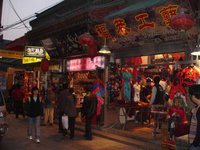 While we were checking out the shops, I saw a sign which said foot massage for just RMB38. And since my feet were aching, I could not resist. When we got back to the hotel, I went straight to bed.
While we were checking out the shops, I saw a sign which said foot massage for just RMB38. And since my feet were aching, I could not resist. When we got back to the hotel, I went straight to bed.
 We had to get up early today for our visit to the Great Wall of China (萬里長城). The day before, we booked seats with the travel agent in our hotel for a package tour to the Great Wall and Ming Tombs (明朝十三陵). The price was RMB150 which we felt was a good deal since it included transportation, entrance to the sites, and lunch.
We had to get up early today for our visit to the Great Wall of China (萬里長城). The day before, we booked seats with the travel agent in our hotel for a package tour to the Great Wall and Ming Tombs (明朝十三陵). The price was RMB150 which we felt was a good deal since it included transportation, entrance to the sites, and lunch.
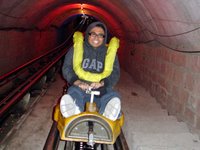 There were optional fees which included RMB60 for a slide car ride up the mountain and down back; as well as RMB40 for extra sites which we could not get the agency to explain in English. So we opted for the slide car ride. Another option up the mountain was a cable car ride but the tour they offered did not have that option since the drop off point for the cable car was in another part of the Great Wall.
There were optional fees which included RMB60 for a slide car ride up the mountain and down back; as well as RMB40 for extra sites which we could not get the agency to explain in English. So we opted for the slide car ride. Another option up the mountain was a cable car ride but the tour they offered did not have that option since the drop off point for the cable car was in another part of the Great Wall.
 Anyway, the bus passed by for us in the hotel at 7:15 a.m. and there were already other passengers. The sad thing was the guide was speaking in Chinese since it turns out, we were the only foreigners on the bus.
Anyway, the bus passed by for us in the hotel at 7:15 a.m. and there were already other passengers. The sad thing was the guide was speaking in Chinese since it turns out, we were the only foreigners on the bus.
On the way, one of the passengers started a shouting match with the guide. We had figured that it had something to do with the payment since the guides were doing rounds of the passengers collecting money. It turns out, the optional fees were not optional and they were collecting the said fees from those who did not pay. So that’s why one of the passengers got hysterical since she thought it was optional and didn’t want to pay for it. So we too had to pay the RMB40 which we opted not to take. Oh well!
 The northern pass of Juyongguan Pass is known as Badaling. This particular area of the Great Wall is the most visited by tourists. This portion of the Great Wall is 7.8 meters high and 5 meters wide.
The northern pass of Juyongguan Pass is known as Badaling. This particular area of the Great Wall is the most visited by tourists. This portion of the Great Wall is 7.8 meters high and 5 meters wide.
As we neared Badaling, the view outside of the tall mountains and traces of the Great Wall was just awe-inspiring. When we exited the bus at the drop off point, a gush of frigid wind hit us. We completely forgot that it was much colder here than the city proper since we were high up in the mountains. It was so cold that I had to put on my hood to keep my ears warm. I should have purchased gloves the day before since the stalls were selling them at exorbitantly high prices. So I had to make do with the pouch in my sweater to keep my hands warm.
 The Great Wall of China (萬里長城) was built to protect the various dynasties from raids by Hunnic, Mongol, Turkic, and other nomadic tribes coming from areas in modern-day Mongolia and Manchuria. Although several walls were built since the 3rd century BC, the most famous being built between 220 BC and 200 BC by the first emperor of China, Qin Shi Huang, little of those earlier walls remain. It is the world's longest man-made structure, stretching over 6,352 kilometers. Mao Zedong had a saying: 不到長城非好漢, "You're not a hero if you haven't climbed the Great Wall."
The Great Wall of China (萬里長城) was built to protect the various dynasties from raids by Hunnic, Mongol, Turkic, and other nomadic tribes coming from areas in modern-day Mongolia and Manchuria. Although several walls were built since the 3rd century BC, the most famous being built between 220 BC and 200 BC by the first emperor of China, Qin Shi Huang, little of those earlier walls remain. It is the world's longest man-made structure, stretching over 6,352 kilometers. Mao Zedong had a saying: 不到長城非好漢, "You're not a hero if you haven't climbed the Great Wall."
 We boarded the slide cars up the mountain which brought us straight to the entrance of the Great Wall. This was the third UNESCO World Heritage Site I visited in just two days. I guess my high spirits just overtook me as I walked the wall and I didn’t realize I had walked a long distance already. The wall stretched as far as the eye could see. The experience was just surreal.
We boarded the slide cars up the mountain which brought us straight to the entrance of the Great Wall. This was the third UNESCO World Heritage Site I visited in just two days. I guess my high spirits just overtook me as I walked the wall and I didn’t realize I had walked a long distance already. The wall stretched as far as the eye could see. The experience was just surreal.
 The guides gave us an hour and a half to do our thing. Then we were off to the next destination. I thought our next stop was lunch but we were herded into a jewelry shop, and after that, a sort of food supermarket which sold vacuum-packed Peking duck, dried fruits, pastries and breads and the like. Lunch was beside the supermarket which I was not satisfied with since it was mostly rice and vegetables. So I ended up buying corn and a grilled sausage from the vendors outside.
The guides gave us an hour and a half to do our thing. Then we were off to the next destination. I thought our next stop was lunch but we were herded into a jewelry shop, and after that, a sort of food supermarket which sold vacuum-packed Peking duck, dried fruits, pastries and breads and the like. Lunch was beside the supermarket which I was not satisfied with since it was mostly rice and vegetables. So I ended up buying corn and a grilled sausage from the vendors outside.
I would later read in Wikitravel a warning about tours being touted in the Forbidden City area with prices between RMB100 to 150 since these tours earned from commissions from all these outlets they bring their passengers to. Although ours was legitimate since it came from our hotel travel agency, I figured our tour was cheap since they earned if any of the passengers bought from the shops they brought us to.
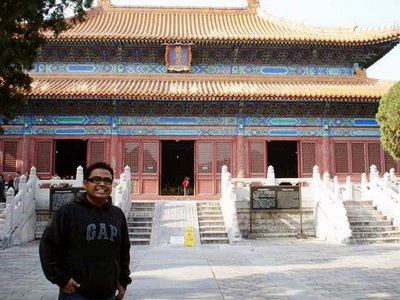 After lunch, we went to one of the Ming Tombs (明朝十三陵). There are thirteen imperial tombs of the Ming Dynasty scattered in an area of about 40 square kilometers in the Changping District of Beijing. They were inscribed in the UNESCO World Heritage List in 2003.
After lunch, we went to one of the Ming Tombs (明朝十三陵). There are thirteen imperial tombs of the Ming Dynasty scattered in an area of about 40 square kilometers in the Changping District of Beijing. They were inscribed in the UNESCO World Heritage List in 2003.
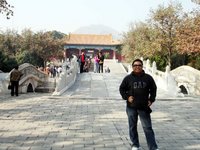 It was the Yongle Emperor, the third Ming emperor, who chose the site of the Ming Tombs. Ruling from 1402 to 1424, he was responsible for moving the capital from Nanjing to Beijing and is credited with envisioning the layout of the ancient city of Beijing. After the construction of the Forbidden City in 1420, Yongle selected his burial site and created his own mausoleum. All in all, 13 out of 16 Ming Dynasty emperors were buried in the area. The tombs of the first two Ming Emperors are located near Nanjing, the capital city during their reigns.
It was the Yongle Emperor, the third Ming emperor, who chose the site of the Ming Tombs. Ruling from 1402 to 1424, he was responsible for moving the capital from Nanjing to Beijing and is credited with envisioning the layout of the ancient city of Beijing. After the construction of the Forbidden City in 1420, Yongle selected his burial site and created his own mausoleum. All in all, 13 out of 16 Ming Dynasty emperors were buried in the area. The tombs of the first two Ming Emperors are located near Nanjing, the capital city during their reigns.
 Only three tombs are open to the public namely Changling, Dingling and Zhaoling. Of these, only the tumulus (underground chamber) of the Dingling Tomb has been opened. Chinese archaeologists are excited about opening the Changling tumulus housing the powerful Yongle Emperor and possibly containing the remaining copy of the Great Dictionary of Yongle (Yongle Dadian).
Only three tombs are open to the public namely Changling, Dingling and Zhaoling. Of these, only the tumulus (underground chamber) of the Dingling Tomb has been opened. Chinese archaeologists are excited about opening the Changling tumulus housing the powerful Yongle Emperor and possibly containing the remaining copy of the Great Dictionary of Yongle (Yongle Dadian).
We visited the Zhaoling Tomb (昭陵)
of Zhu Zaihou (朱載垕), also known as Emperor Muzong (穆宗) or the Longqing Emperor (隆慶) and his three empresses. His reign lasted only six years from1566 to 1572. It wasn't the best of the Ming Tombs though and I felt our guides were just being wise since it had the cheapest entrance fee at RMB30. As they say, "If you've seen one, you've seen them all." Hehe!
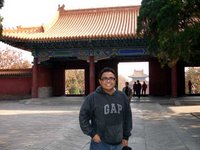 Anyway, after a brief tour of the tomb, we were back to the bus. I was expecting that the extra site was another Ming Tomb but instead they brought us to a wax museum about the Ming Dynasty. Since I’ve seen so many museums before, I would have wanted to stay in the bus and save my money but the guide refused since I think they paid a group rate. So obviously, they were also able to earn from that.
Anyway, after a brief tour of the tomb, we were back to the bus. I was expecting that the extra site was another Ming Tomb but instead they brought us to a wax museum about the Ming Dynasty. Since I’ve seen so many museums before, I would have wanted to stay in the bus and save my money but the guide refused since I think they paid a group rate. So obviously, they were also able to earn from that.
But the museum was not bad since the life-size dioramas were really great and thanks to the English translations of the various scenes, I was able to learn a lot. It was just that I would have wanted to spend the RMB40 on another Ming Tomb.
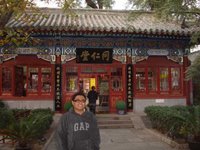 With that done, the group went back to central Beijing. I thought the tour was over but they brought us to one last stop. We went to a traditional Chinese drugstore next which was called the Beijing Tongrentang. I felt it was consistent with the Wikitravel warning. Hehe! They were giving a lecture but it was in Chinese so we were able to excuse ourselves from the sales talk which I felt they were doing in there. But the building had a lot of history since it provided medicine for royalty since 1723. It even had the golden dragon on its ceiling, a sign that it served the emperor.
With that done, the group went back to central Beijing. I thought the tour was over but they brought us to one last stop. We went to a traditional Chinese drugstore next which was called the Beijing Tongrentang. I felt it was consistent with the Wikitravel warning. Hehe! They were giving a lecture but it was in Chinese so we were able to excuse ourselves from the sales talk which I felt they were doing in there. But the building had a lot of history since it provided medicine for royalty since 1723. It even had the golden dragon on its ceiling, a sign that it served the emperor.
On the way to the Tongrentang, we saw a tourist information office right beside what looked like Beihai Park. So we told the guides that we would stay behind. From there, we walked towards the office and asked some questions. Got myself a better map of Beijing. Rhea and Marlon wanted to go shopping since it was their last chance. While I wanted to check out the park. So from there, we parted ways and did our own thing.
 Beijing (北京) is the capital of the People's Republic of China. It is the political, cultural, domestic and international exchange center of the country and one of the largest historical and cultural cities and ancient capitals in the world. Man first appeared in Beijing 700,000 years ago as evidenced by the primitive Peking Man community in Zhoukoudian.We arrived in Beijing at 5:41 a.m. I'd say the temperature was close to 15 degrees Celsius. The trains are very efficient, departing on the dot and arriving on time. First on the list of things to do was to find a hotel for us to freshen up and drop off our luggage. A lot of hotel agents would approach passengers like us for hotel accommodations. After I purchased my train ticket, another approached us but had our ears this time since we just wanted to get it off our minds. So when we asked about the price and we felt the deal was good, we said yes.
Beijing (北京) is the capital of the People's Republic of China. It is the political, cultural, domestic and international exchange center of the country and one of the largest historical and cultural cities and ancient capitals in the world. Man first appeared in Beijing 700,000 years ago as evidenced by the primitive Peking Man community in Zhoukoudian.We arrived in Beijing at 5:41 a.m. I'd say the temperature was close to 15 degrees Celsius. The trains are very efficient, departing on the dot and arriving on time. First on the list of things to do was to find a hotel for us to freshen up and drop off our luggage. A lot of hotel agents would approach passengers like us for hotel accommodations. After I purchased my train ticket, another approached us but had our ears this time since we just wanted to get it off our minds. So when we asked about the price and we felt the deal was good, we said yes. They had a vehicle which took us to the hotel which was along Tiāntán Lu (Temple of Heaven Road) and thus, right beside the Temple of Heaven. When we got there, they then let us check the room first which was to me, a sign that they were not the types that would cheat us. The room was actually two rooms with a connecting door so we had four beds and one bathroom for the price of RMB230 a night. Since there were three of us, we ended up spending about RMB75 each. So after getting settled and munching on the food we had left, we were off.First on our list of places to visit was (天坛) Tiāntán or the Temple of Heaven which was right in front of the hotel. But the north entrance was a few minutes walk down the road. It is a UNESCO World Heritage Site, which is one of six inscribed sites in the jurisdiction of Beijing alone.
They had a vehicle which took us to the hotel which was along Tiāntán Lu (Temple of Heaven Road) and thus, right beside the Temple of Heaven. When we got there, they then let us check the room first which was to me, a sign that they were not the types that would cheat us. The room was actually two rooms with a connecting door so we had four beds and one bathroom for the price of RMB230 a night. Since there were three of us, we ended up spending about RMB75 each. So after getting settled and munching on the food we had left, we were off.First on our list of places to visit was (天坛) Tiāntán or the Temple of Heaven which was right in front of the hotel. But the north entrance was a few minutes walk down the road. It is a UNESCO World Heritage Site, which is one of six inscribed sites in the jurisdiction of Beijing alone. The ordinary entrance ticket is RMB10 but this was just so that you could enter the grounds. To enter the major buildings, you would have to get a through ticket which was RMB30.The Temple of Heaven, covering an area of 2.7 million square meters, is the largest extant temple complex in China. First built in 1420, it served as a place for the emperors of the Ming and Qing Dynasties to worship heaven and pray for an abundant harvest. It is famous for its precise layout, unique architectural structures and elegant decorations.On the north end is the Hall of Prayer for a Good Harvest which is the structure we see in most brochures and books. While on the opposite end is the Imperial Vault of Heaven and the Circular Mound Altar. The three structures are perfectly aligned along a north-south axis, connected by a terrace called the divine pavement which is 360 meters long and 2.5 meters high.
The ordinary entrance ticket is RMB10 but this was just so that you could enter the grounds. To enter the major buildings, you would have to get a through ticket which was RMB30.The Temple of Heaven, covering an area of 2.7 million square meters, is the largest extant temple complex in China. First built in 1420, it served as a place for the emperors of the Ming and Qing Dynasties to worship heaven and pray for an abundant harvest. It is famous for its precise layout, unique architectural structures and elegant decorations.On the north end is the Hall of Prayer for a Good Harvest which is the structure we see in most brochures and books. While on the opposite end is the Imperial Vault of Heaven and the Circular Mound Altar. The three structures are perfectly aligned along a north-south axis, connected by a terrace called the divine pavement which is 360 meters long and 2.5 meters high. Some guide books say that the area it covers is twice as large as the Forbidden City. So it is important that you enter through the north or south entrance or you’ll end up wasting a lot of time entering through the sides and see nothing much too.Near the south entrance was a tourist information office. When the staff saw we were approaching, they immediately stood up and met us. We asked which bus we could take to get to Tian’anmen Square (天安門廣場). So they gave us a piece of paper with the bus number and a message in Chinese for the conductor to read. When the conductor read our note, she was very helpful and informed us when to get off. Buses within the city center area have a flat rate of RMB1.
Some guide books say that the area it covers is twice as large as the Forbidden City. So it is important that you enter through the north or south entrance or you’ll end up wasting a lot of time entering through the sides and see nothing much too.Near the south entrance was a tourist information office. When the staff saw we were approaching, they immediately stood up and met us. We asked which bus we could take to get to Tian’anmen Square (天安門廣場). So they gave us a piece of paper with the bus number and a message in Chinese for the conductor to read. When the conductor read our note, she was very helpful and informed us when to get off. Buses within the city center area have a flat rate of RMB1. Most people in China do not speak English. So a Mandarin phrasebook with Chinese characters would come in handy so that you could just point at it when needed. Without the characters, it would be a challenge since intonation is also very important. If you have Chinese friends, you could also ask them to prepare flash cards which you could show when needed; which is what I did for my train ticket, asking our guide in Fuzhou to prepare me a note that I needed a train ticket for Shanghai leaving on November 3.
Most people in China do not speak English. So a Mandarin phrasebook with Chinese characters would come in handy so that you could just point at it when needed. Without the characters, it would be a challenge since intonation is also very important. If you have Chinese friends, you could also ask them to prepare flash cards which you could show when needed; which is what I did for my train ticket, asking our guide in Fuzhou to prepare me a note that I needed a train ticket for Shanghai leaving on November 3.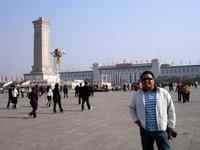 Tian’anmen Square (left) is said to be the largest city center square in the world. It is named after the Tian'anmen Gate (天安門) or Gate of Heavenly Peace. After taking photos at the (前門) Qianmen Gate (above right) which is at the southern end of the square and the Monument to the People's Heroes (人民英雄紀念碑), we proceeded to the (毛主席纪念堂) Chairman Mao Memorial Hall (below right) to view the remains of Mao Zedong.The hall is a square building with 44 octagonal granite pillars. Outside the north and south entrances are two groups of statues 8.7 meters high. The building is solemn and grand with the remains of Chairman Mao enshrined in a crystal coffin in the reverence hall.
Tian’anmen Square (left) is said to be the largest city center square in the world. It is named after the Tian'anmen Gate (天安門) or Gate of Heavenly Peace. After taking photos at the (前門) Qianmen Gate (above right) which is at the southern end of the square and the Monument to the People's Heroes (人民英雄紀念碑), we proceeded to the (毛主席纪念堂) Chairman Mao Memorial Hall (below right) to view the remains of Mao Zedong.The hall is a square building with 44 octagonal granite pillars. Outside the north and south entrances are two groups of statues 8.7 meters high. The building is solemn and grand with the remains of Chairman Mao enshrined in a crystal coffin in the reverence hall.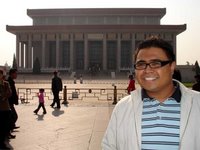 Just a note, you are not allowed to bring bags, more so cameras inside. So you could either ask a companion to wait outside and hold them for you or deposit them in the baggage storage center across the street for a fee. Entrance to the hall however is free. We made it in time since the hall was closing at 11:30 a.m.After visiting the hall, and getting our bags back, we decided to walk around and look for a place to eat lunch. Along the way, we passed by the Beijing 2008 Olympics souvenir shop but didn't get to buy anything since everything was just so pricey!
Just a note, you are not allowed to bring bags, more so cameras inside. So you could either ask a companion to wait outside and hold them for you or deposit them in the baggage storage center across the street for a fee. Entrance to the hall however is free. We made it in time since the hall was closing at 11:30 a.m.After visiting the hall, and getting our bags back, we decided to walk around and look for a place to eat lunch. Along the way, we passed by the Beijing 2008 Olympics souvenir shop but didn't get to buy anything since everything was just so pricey!
 We found a Chinese fast food restaurant where I ordered this round pancake with pork inside which reminded me of murtabak. It was during lunch that Rhea and Marlon decided that they would take a train back to Guangzhou since plane tickets were RMB1,300 one-way. They did not buy tickets when we were at the station in the morning since they wanted to check out flight options. They just could not stand the long travel. But since plane tickets were more than twice the cost of the train, they opted for the latter. So we trooped back to the Beijing Train Station to get their tickets which were about RMB450. Now that the sun was out, we were also able to take photos in front of the train station.
We found a Chinese fast food restaurant where I ordered this round pancake with pork inside which reminded me of murtabak. It was during lunch that Rhea and Marlon decided that they would take a train back to Guangzhou since plane tickets were RMB1,300 one-way. They did not buy tickets when we were at the station in the morning since they wanted to check out flight options. They just could not stand the long travel. But since plane tickets were more than twice the cost of the train, they opted for the latter. So we trooped back to the Beijing Train Station to get their tickets which were about RMB450. Now that the sun was out, we were also able to take photos in front of the train station.
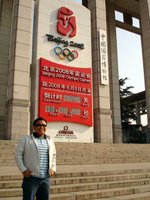 On the way to the subway station, we took photos in front of the Beijing 2008 Olympic Games countdown clock in front of the National Museum of China. The Games are opening at 8 p.m. of August 8, 2008 (8/8/08) since as you all know, "8" is a lucky number for the Chinese.
On the way to the subway station, we took photos in front of the Beijing 2008 Olympic Games countdown clock in front of the National Museum of China. The Games are opening at 8 p.m. of August 8, 2008 (8/8/08) since as you all know, "8" is a lucky number for the Chinese.
I think we were able to troop back to Tian'anmen at 2 p.m. Since we were behind schedule, we rushed to take more photos. And one of them was in front of the Tian'anmen Gate itself, an image of Tian'anmen Square which is familiar all over the world.
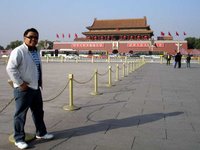 The 33.7 meter-high gate was the original entrance of the imperial city. And it's middle entrance was reserved for the emperor. It was from this gate that emperors announced their edicts.
The 33.7 meter-high gate was the original entrance of the imperial city. And it's middle entrance was reserved for the emperor. It was from this gate that emperors announced their edicts.
With that done, it was time to fulfill my dream of stepping foot in the Forbidden City (紫禁城). Known as the Palace Museum (故宫), the Forbidden City was the residence of 24 emperors of the Ming and Qing Dynasties. It is among the UNESCO World Heritage sites in Beijing.
 Located in the center of the central axial line of Beijing, the imperial palace was first constructed in 1406. It has more than 9,000 palaces, halls and rooms, and contains a large number of valuable cultural relics. The entrance ticket to the palace was RMB40.
Located in the center of the central axial line of Beijing, the imperial palace was first constructed in 1406. It has more than 9,000 palaces, halls and rooms, and contains a large number of valuable cultural relics. The entrance ticket to the palace was RMB40.
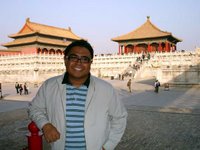 We were warned by our Chinese hosts that many of the structures would be covered by scaffolding since they were restoring the old buildings in time for the Beijing Olympics in 2008. It was good that the restoration work at the Temple of Heaven was already completed which is why if you notice in the photos, the colors of the structures were very vibrant. Some structures in the Forbidden City were also completed.
We were warned by our Chinese hosts that many of the structures would be covered by scaffolding since they were restoring the old buildings in time for the Beijing Olympics in 2008. It was good that the restoration work at the Temple of Heaven was already completed which is why if you notice in the photos, the colors of the structures were very vibrant. Some structures in the Forbidden City were also completed.
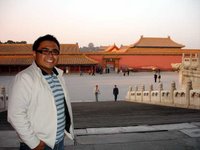 As we entered the gates of the main palace complex, I could hear the opening notes of "The Last Emperor" playing in my mind. But the sad part about our visit was the main hall of the palace was completely covered by scaffolding! There goes my photo with the main throne room.
As we entered the gates of the main palace complex, I could hear the opening notes of "The Last Emperor" playing in my mind. But the sad part about our visit was the main hall of the palace was completely covered by scaffolding! There goes my photo with the main throne room.
You'd know if restoration on a structure was completed by the colors. The structures above have yet to be restored. While the one below is already done.
 We stayed until closing time, visiting as many sites as we could since the palace complex was just so vast. From the Palace Museum, we took a walk towards the southern end of Tian'anmen where there was an internet shop.
We stayed until closing time, visiting as many sites as we could since the palace complex was just so vast. From the Palace Museum, we took a walk towards the southern end of Tian'anmen where there was an internet shop.
The regular internet shops are regulated by the government requiring ID cards before you could use them. This was to prevent minors from getting hooked to online gaming. But for tourist internet shops, they weren't too strict about IDs since the catch was the prices were sky high! They charged RMB20 per hour which was roughly PHP130.
Tomorrow we visit the Great Wall of China!
 What I thought was Beihai Park was actually Sichahai. I think I got my directions wrong so instead of going south towards Beihai, I walked north. As I entered, a group of rickshaw drivers started to pester me. They were showing me a map and saying that it was too far to walk. And that they would take me around the sites. I pretended not to be interested and from RMB180 which is the price in the map, they offered to take me around for an hour for RMB50.
What I thought was Beihai Park was actually Sichahai. I think I got my directions wrong so instead of going south towards Beihai, I walked north. As I entered, a group of rickshaw drivers started to pester me. They were showing me a map and saying that it was too far to walk. And that they would take me around the sites. I pretended not to be interested and from RMB180 which is the price in the map, they offered to take me around for an hour for RMB50. So we went around beginning in Houhai or the west bank. I did not realize it until I did some research that what I actually did was a tour of the Beijing hutongs, which are narrow maze-like lanes and alleys that were typical of Beijing communities in the olden days.
So we went around beginning in Houhai or the west bank. I did not realize it until I did some research that what I actually did was a tour of the Beijing hutongs, which are narrow maze-like lanes and alleys that were typical of Beijing communities in the olden days. The driver took me to an alley with a lot of shops. I wasn't the one who wanted to go shopping but I just hit the tourist shop area of Beijing where in my opinion, the best Chinese souvenirs could be purchased at affordable prices, if you know how to bargain. I got myself an English version of Quotations from Chairman Mao Zedong (毛主席语录) which is known in the West as The Little Red Book. It is second only to the Bible in volume with over 900 million copies printed.
The driver took me to an alley with a lot of shops. I wasn't the one who wanted to go shopping but I just hit the tourist shop area of Beijing where in my opinion, the best Chinese souvenirs could be purchased at affordable prices, if you know how to bargain. I got myself an English version of Quotations from Chairman Mao Zedong (毛主席语录) which is known in the West as The Little Red Book. It is second only to the Bible in volume with over 900 million copies printed. We went around more hutongs but since it was already getting dark, I wasn't able to appreciate it that much. The driver also brought me to some traditional houses which were converted into museums but I didn't want to spend for entrance which was about RMB40 each.
We went around more hutongs but since it was already getting dark, I wasn't able to appreciate it that much. The driver also brought me to some traditional houses which were converted into museums but I didn't want to spend for entrance which was about RMB40 each. When the tour ended, I took a walk again in Sichahai, this time along Lotus Lane which was flooded in lights (above right). The restaurants looked very appealing but again, I was on a very tight budget so I decided to have dinner elsewhere. I saw a structure from a distance and it turned out to be the Drum Tower or Gulou. So I walked towards it.
When the tour ended, I took a walk again in Sichahai, this time along Lotus Lane which was flooded in lights (above right). The restaurants looked very appealing but again, I was on a very tight budget so I decided to have dinner elsewhere. I saw a structure from a distance and it turned out to be the Drum Tower or Gulou. So I walked towards it. I found myself on a shopping street and decided to keep walking southwards towards the hotel. Along the way, I found dinner! It was siopao! Haha! There were different kinds such as those stuffed with pork, and the rest were stuffed with various vegetables and tofu. I don't think we have vegetable-stuffed siopao in the Philippines. The clincher here was that each piece was just RMB0.80 or roughly PHP5 each! Now that was a cheap dinner. Haha!
I found myself on a shopping street and decided to keep walking southwards towards the hotel. Along the way, I found dinner! It was siopao! Haha! There were different kinds such as those stuffed with pork, and the rest were stuffed with various vegetables and tofu. I don't think we have vegetable-stuffed siopao in the Philippines. The clincher here was that each piece was just RMB0.80 or roughly PHP5 each! Now that was a cheap dinner. Haha! While we were checking out the shops, I saw a sign which said foot massage for just RMB38. And since my feet were aching, I could not resist. When we got back to the hotel, I went straight to bed.
While we were checking out the shops, I saw a sign which said foot massage for just RMB38. And since my feet were aching, I could not resist. When we got back to the hotel, I went straight to bed.

























